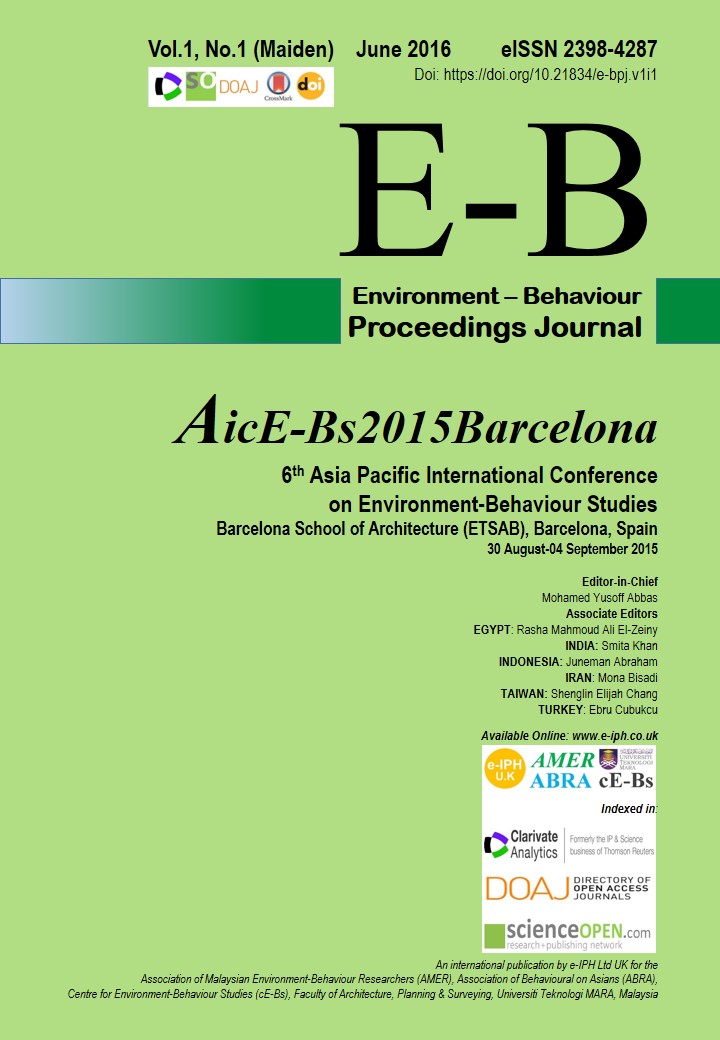Virtual Environment as a Design Tool for Sustainable Residential Spaces in Light of Theory of Planned Behavior
DOI:
https://doi.org/10.21834/e-bpj.v1i1.227Keywords:
Virtual Environment, Residential Spaces, Sustainable Design, Theory of Planned BehaviorAbstract
This study aims to reveal the impact of Virtual Environment as a design tool on the interior architect's design behavior towards adopting sustainable residential interior design practices. This approach is guided by the Theory of Planned Behaviour as a theoretical framework; the purpose as such would serve to bridge the gap between theoretical knowledge and its practical implementation to promote sustainable design practices. Findings revealed that Virtual Environment is anticipated to assist the interior architect in integrating the complex sustainable residential design objectives, and thus positively affect the interior architect's behavioral performance towards embracing sustainable residential design solutions.
References
Abdel-Hadi, Aleya, & Aboulgheitb, Iman. (2012). Assessing Housing Interior Sustainability in a New Egyptian City. Procedia - Social and Behavioural Sciences, 565-568. DOI: https://doi.org/10.1016/j.sbspro.2012.12.249
Abdel-Hadi, Aleya. (2012). Culture, Quality of life, Globalization and Beyond Procedia - Social and Behavioural Sciences, 14. DOI: https://doi.org/10.1016/j.sbspro.2012.08.011
Abo Neama, Wael Ahmed Shaaban. (2012). Protect our Environment through Developing Architectural Design towards Sustainability by Applying its Principles into Design Tools. Procedia - Social and Behavioral Sciences, 736. DOI: https://doi.org/10.1016/j.sbspro.2012.12.263
Bako, Zinas Zachariah, & Jusan, Mahmud Mohd. (2012). Motivational Factors Influencing Housing Interior Finish Choice and Preference. Procedia - Social and Behavioral Sciences, 180. DOI: https://doi.org/10.1016/j.sbspro.2012.03.020
Bertol, Daniela, & Foell, David. (1997). Designing Digital Space - An Architects Guide to Virtual reality. John Wiley and Sons, Inc., New York, 67, 69, 70, 94, 95, 104, 116-118, 126, 212, 221, 222, 225, 310-312.
Coleman, Cindy (2002). Interior Design Handbook of Professional Practice. McGraw-Hill, United States of America, 561, 563, 565, 569, 575, 577.
Cottrell, Michelle. (2014). Guide to the LEED® Green Associate V4 Exam. John Wiley & Sons, Inc., New Jersey, 11, 12
Dong, Wei. (1998). Computer Visualization: An Integrated Approach for Interior Design and Architecture McGraw-Hill, Inc., New York, 4, 6, 10-13, 14, 124, 152, 182, 184.
Glanz, Karen, Rimer, Barbara K., & Viswanath, K. (2008). Health Behaviour and Health Education: Theory, Research, and Practice. (4th ed.). John Wiley & Sons, Inc., United States of America, 71, 73.
Husin, Sharifah Nor Fairuz Syed, & Harith, Zarina Yasmin Hanur. (2012). The Performance of Daylight through Various Type of Fenestration in Residential Building. Procedia - Social and Behavioral Sciences, 197. DOI: https://doi.org/10.1016/j.sbspro.2012.03.022
Ismail, Faridah, Jabar, Izatul Laili, Janipha, Nurul Afida Isnaini, & Razali, Rozana. (2015). Measuring the Quality of Life in Low Cost Residential Environment. Procedia - Social and Behavioral Sciences, 272. DOI: https://doi.org/10.1016/j.sbspro.2014.10.232
Isnin Zarina, Ramli, Rohaslinda, Hashim, Ahmad Ezanee, & Ali, Irwan M. (2012). Sustainable Issues in Low Cost Housing Alteration Projects. Procedia - Social and Behavioral Sciences, 394. DOI: https://doi.org/10.1016/j.sbspro.2012.03.043
Jamaludina, Nazhatulzalkis, Mohammeda, Nurul Izma, Khamidib, Mohd Faris, & Abdul Wahaba, Suriani Ngah. (2015). Thermal Comfort of Residential Building in Malaysia at Different Micro-Climates. Procedia - Social and Behavioral Sciences, 615. DOI: https://doi.org/10.1016/j.sbspro.2015.01.063
Jones, John Christopher. (1980). Design Methods-seeds of human future; John Wiley & Sons Ltd., U.K, 3, 4, 10-12.
Ken Sanders, AIA. (1996). The Digital Architect.John Wiley & Sons, Inc. New York, 96, 97, 405.
Keonil, Nuchnapang, & Sahachaisaeree, Nopadon. (2012). Architectural Design towards Energy Optimization: A Case of Residential Buildings in Bangkok. Procedia - Social and Behavioral Sciences, 285, 286. DOI: https://doi.org/10.1016/j.sbspro.2012.04.192
Kim, Do-Young, Choe, Yoon, & Kim, Sung-Ah. (2015). Implementing a Digital Model for Smart Space Design: Practical and Pedagogic Issues. Procedia - Social and Behavioral Sciences, 3306. DOI: https://doi.org/10.1016/j.sbspro.2015.01.998
Lawson, Bryan. (1980). How Designers Think. The Architectural Press Ltd., London, 24-25, 40, 43, 47, 64, 72, 86-99.
Mahmud, Shahril Anwar, Ahmad, Abdullah Sani & Abdullah, Aminatuzuhariah Megat. (2012). Lifestyle Orientation and the Residential Environment: An Exploratory Review. Procedia - Social and Behavioral Sciences, 306. DOI: https://doi.org/10.1016/j.sbspro.2012.07.028
Memikoğlua, İpek. (2014). Utilization of Second Life as a Tool for Spatial Learning in Interior Architecture. Procedia - Social and Behavioral Sciences, 1289 DOI: https://doi.org/10.1016/j.sbspro.2014.01.384
Musaa, A.R., Abdullaha, N.A.G., Che-Ania, b, A.I., Tawilla, b, N.M., & Tahira, M.M. (2012). Indoor Environmental Quality for UKM Architecture Studio: An Analysis on Lighting Performance. Procedia - Social and Behavioral Sciences, 318. DOI: https://doi.org/10.1016/j.sbspro.2012.09.386
Nazmy, H.S. (2013). Virtual Environment as a Design Tool for Residential Spaces. (Unpublished master's thesis). Helwan University, Egypt.
Norouzia, Nima, Shabakb, Maryam, Rashid Bin Embic, Mohamed, & Khand, Tareef Hayat. (2015). The architect, the client and effective communication in architectural design practice. Procedia - Social and Behavioral Sciences, 637. DOI: https://doi.org/10.1016/j.sbspro.2015.01.413
Pieter den Hartog, Johannes. (2004). Designing Indoor Climate: A thesis on the integration of indoor climate analysis in architectural design, 3-5.
Pile, John F. (2007). Interior Design. Pearson Education, Inc., New Jersey, 37, 38, 60-65, 139, 140.
Porter, Tom (1979). How Architects Visualize. Cassell Ltd, London, 16, 18, 20, 22, 24, 27, 28, 60-63, 70, 91, 180.
Haddad, Robert. (2014). Research and Methodology for Interior Designers. Procedia - Social and Behavioral Sciences, 285. DOI: https://doi.org/10.1016/j.sbspro.2014.01.1343
Smithies, K. W. (1981). Principles of Design in Architecture. Van Nostrand Reinhold Co. Ltd., New York, 3-5, 34, 35, 39-42, 44-46, 55-57.
Suyoto, William, Indraprastha, Aswin, & Purbo, Heru W. (2015). Parametric Approach as a Tool for Decision-making in Planning and Design Process. Case study: Office Tower in Kebayoran Lama. Procedia - Social and Behavioral Sciences, 328. DOI: https://doi.org/10.1016/j.sbspro.2015.05.098
Unwin, Simon. (1997). Analyzing Architecture. Routledge, London, 25-27, 29-31, 33, 44, 45, 53, 54, 77, 86-87.
Whyte, Jennifer. (2002). Virtual Reality and the Built Environment. Architectural Press, Great Britain, 3, 4, 7. 51, 53, 54-56, 60, 66, 68, 78-80, 92-96
Downloads
Published
How to Cite
Issue
Section
License
Copyright (c) 2016 Hebatalla Sherin Nazmy

This work is licensed under a Creative Commons Attribution-NonCommercial-NoDerivatives 4.0 International License.





